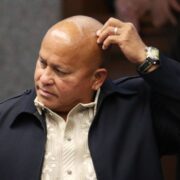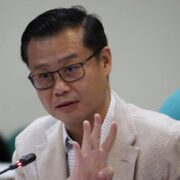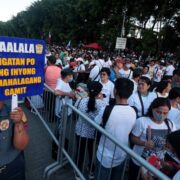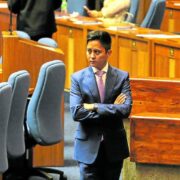End the export of Filipinos

President Marcos has a dream: to “make overseas work a choice rather than a necessity” one day.
Speaking at a ceremony in Malacañang last week to honor individuals and organizations for excelling in their fields and championing overseas Filipino workers (OFWs), the President cited reforms in governance and economic development that, he said, would provide Filipinos with more and better opportunities here.
But he also recognized that Filipino talents would continue to cross international borders in search of better-paying jobs. “Against this backdrop, the Philippines remains committed to ensuring that the rights and well-being of our overseas Filipinos and their families are safeguarded at all times, wherever they may be,” Mr. Marcos said.
And there’s the rub.
Cornerstone of economic policy
As dramatic as it sounds, it’s hard to take the President’s “dream” seriously when a cornerstone of his administration’s economic policy is precisely geared toward the exportation, or exploitation, of Filipino workers, whose remittances help keep the economy afloat. It’s even harder to appreciate his vision in the face of the realities that push our compatriots to seek greener pastures abroad.
As the think tank Migration Policy Institute (MPI) noted in an article published in January, the Philippines has relied on international migration as an economic engine since the enactment of the Labor Code under Presidential Decree No. 442, signed by Mr. Marcos’ late father and namesake in 1974.
That law explicitly mandates the government to “promote the overseas employment of Filipino workers through a comprehensive market promotion and development program,” and “to recruit and place workers for overseas employment on a government-to-government arrangement and in such other sectors as policy may dictate.”
It has been 50 years since the Labor Code was passed, and as the Philippines emerges from the COVID-19 pandemic that hindered migration globally, “the country is doubling down on its ambitions to serve as a provider of workers to the world,” the MPI said.
Another indicator of the government’s intentions to continue pursuing overseas employment was the creation of the Department of Migrant Workers (DMW) in December 2021.
10 million OFWs in 200 countries
Born from the ashes of multiple fragmented agencies, the DMW claims to protect OFWs and facilitate reintegration. But its very existence underscores an inherent contradiction at the center of the government’s policies on overseas employment: Instead of creating livelihood opportunities at home, the administration continues to institutionalize migration as a solution, reinforcing the unofficial labor export policy that began in the 1970s.
As a result of such a policy, an estimated 10 million Filipinos now live and work in more than 200 countries, many in temporary or irregular status, according to the MPI report. In 2022, more than 1.2 million OFWs were deployed, more than double the figure in 2020, when much of the world had closed its doors to migrant workers at the height of the pandemic.
Unfortunately, despite the President’s declaration, it’s unlikely that the government will turn its back on OFW remittances, which account for nearly 9 percent of the gross domestic product, in lieu of substantive reforms. Remittances soared to record levels in 2022, reaching $32.5 billion, providing a lifeline to an economy that is still recovering from pandemic shocks, the MPI report said.
Yet, this dependence on OFWs comes at a high cost.
Filipino workers are sent to war zones in the Middle East, caught in the crossfire among combatants, or become victims of illegal recruiters and traffickers, facing potential execution in countries where capital punishment is imposed. Mary Jane Veloso, whose death sentence was commuted by Indonesia and who is set to be transferred to the Philippines, stands as a rare exception to the fate suffered by OFWs on death row abroad.
Preserving workers’ dignity
Such vulnerabilities are the natural consequence of a system that prioritizes dollar inflows over the safety and welfare of the people.
If the President truly aspires to redefine the future of Filipino labor, he must walk his talk by stopping the government’s reliance on labor export and fixing the structural weaknesses that drive migration: corruption, red tape, the patronage system, and government neglect.
Decades of dependence have created a vicious cycle where families invest heavily in education not to keep talent in the country but to export it, and where nurses, doctors, engineers, teachers, and skilled workers are seen as commodities rather than valued pillars of society.
In the end, the President must transform his dream into a vow and a call to action. Ending the labor export policy is not just about economics—it is about preserving the dignity of Filipino workers. Above all, it is about proving to our people they hold the same potential to thrive at home as they do on foreign soil.





















